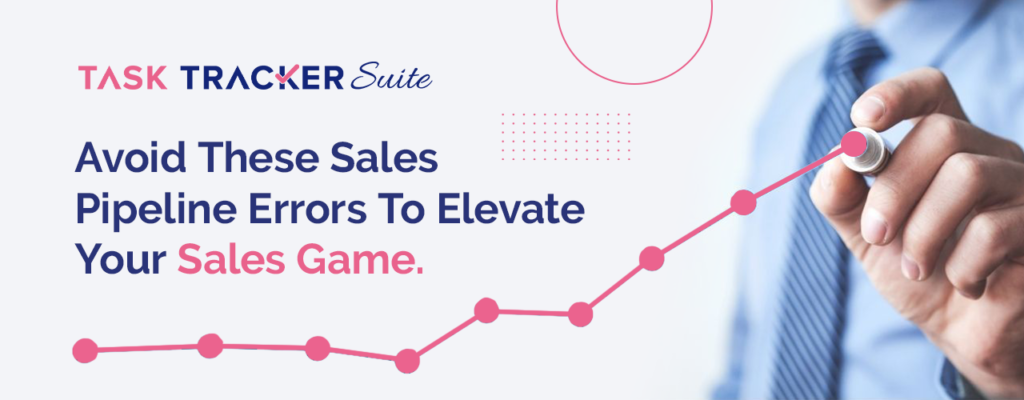
A sales pipeline is a crucial weapon for managing your sales process and achieving revenue goals. But it’s not enough to just have a pipeline. You need to manage it effectively and avoid common pipeline management mistakes that can hurt your sales performance.
As per research by Vantage Point Performance and the Sales Management Association, published in Harvard Business Review, 44% of executives think their organisation’s sales pipeline is ineffective.
In this blog post, we will discover some deadly errors in sales pipeline management and how to avoid them.
1. Not Having a Defined Sales Cycle
A well-defined sales cycle is the foundation of effective sales pipeline management. It guides your sales team in moving a lead from the initial stage to closing a sale.
Your sales process should define the criteria for moving leads between stages in the sales funnel, and every team member should know this strategic approach.
If everyone in your sales team follows their own methods of managing leads, they might get confused about the status, priority, and follow-up actions of each lead. This can cause missed opportunities, wasted time, and lower sales conversion rates.
Also, it will be challenging for you to track the progress of your leads in the sales funnel and identify areas for improvement.
So, develop a clear sales process that suits your business, communicate it to your sales team and provide regular feedback and coaching to ensure everyone follows it.
2. Poor Leads Qualification
Qualifying leads is important to get those contacts who are looking for the solution you offer. By identifying and focusing on high-quality leads, you can maximise your conversion and revenue.
Not qualifying leads will waste time and effort on prospects who are unlikely or difficult to convert, which ultimately leads to wasted resources and missed prospects.
To increase sales and boost your revenue:
- Categorise your leads as per their interest and buying capacity in the sales funnel.
- Develop a lead qualification process that identifies your potential customers, such as budget, decision-making authority, and alignment with your products or services.
- Filter out unqualified leads early in the sales funnel and prioritise the ones with the highest interest and potential.
2. Improper or no leads nurturing
Most businesses forget their leads after the first rejection, or they don’t have an effective strategy to nurture cold leads.
Nurturing leads is a necessary step for moving your prospects through the sales pipeline. You can nurture your cold leads by sharing relevant content and engaging with them on social media or phone. You can use social proofs to show credibility and warm your leads.
If you don’t feed your potential clients with valuable content consistently, your customers will forget you and move to competitors or lose interest in your product or service.
3. Not Tracking the Performance of Sales Pipeline
To manage your sales pipeline for maximum results, track and measure the performance of the sales pipeline. See what’s working and what needs re-optimisation. Especially if you have a low-performing sales team or are looking to increase conversions, you need to monitor your sales funnel.
Not tracking your sales pipeline will lead to longer sales cycles, poor-performing teams and low revenue.
To measure and maintain a sales pipeline, define key performance indicators (KPIs) for your sales team that reflect your revenue goals. This will help you see gaps in your sales pipeline and give you a fair idea of what to improve.
5. Not Training Sales Teams
Sales team members must possess the skills and knowledge to manage sales pipelines effectively. Each team member should know how to qualify leads accurately based on your set metrics.
For all that, focus on improving your sales team’s skills in filtering out leads, conducting follow-ups, sending proposals and updating sales pipelines. You can use various methods, like role-playing, scenario-based training, books and courses to enhance your team’s selling skills.
6. Not Updating the Sales Pipeline
Building a sales pipeline isn’t a one-time job. Many businesses don’t review and update their sales funnel regularly based on the changes in business, market, and customer needs. Over time, sales pipelines become outdated or inaccurate, which can mislead or confuse your sales team and reduce conversion.
For good sales performance, re-optimise your sales cycle with the latest data and remove irrelevant or duplicate leads.
7. Not Using a Sales Tracking Tool
Gone are the days when companies used to rely on spreadsheets or manual tracking for sales pipeline management. If you’re still using that boring spreadsheet or sticky notes placed here and there, it’s time to change.
A sales tracking tool or Sales Tracker is a revolutionary tool that helps you optimise your sales cycle and enhances efficiency. Using sales tracking software, you can manage your client data more accurately, collaborate with your sales team and boost overall sales performance.
You can also view real-time insights to understand if everything is going right and to send timely feedback to your sales team. So, to go with time, become a top performer in your industry, and manage your sales pipeline effectively, try a sales tracking tool.
To Conclude
Managing a sales pipeline is a critical skill for any business that wants to grow and flourish. By avoiding common sales pipeline management mistakes mentioned above and using a sales tracking tool, you will have a healthy sales pipeline, a top-performing sales team and increased revenue.
If you need help with managing your sales pipeline, you can try Sales Tracker. It is a simple and powerful tool that helps you to track, manage, and optimise your sales pipeline more efficiently.
You can try Sales Tracker for free or book a free demo with one of our experts to understand how it can meet your business needs.


Leave a Reply